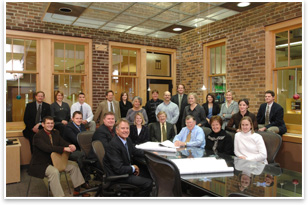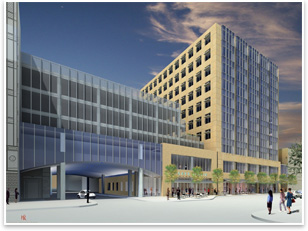
CITIZEN ARCHITECTS by Zach Mortice
Summary: By working with a variety of institutional organizations and being a staunch advocate for their native city, HGA’s Rochester, Minn., branch won the local chamber of commerce’s “Business of the Year” award. An example of how this community involvement translates into the firm’s commitment to increased civic vibrancy is the Minnesota BioBusiness Development Center, a retail and commercial mixed-use tower in downtown Rochester that will cater to businesses that are related to institutional science and research organizations. A deep focus on community involvement and intuitional partnering has earned the Rochester, Minn., branch of Hammel, Green, and Abrahamson (HGA) recognition from their local chamber of commerce. They won the “Business of the Year” award from the Rochester Area Chamber of Commerce, which was awarded to them at their annual member celebration in October. The award honors businesses for their professionalism, contributions to civic vitality, employee leadership, and volunteer activities that enhance the community. “HGA has proven itself again and again, over and over, as a business that embraces the community [and] looks for ways to improve the community,” says John Wade, president of the Rochester Area Chamber of Commerce. The chamber’s December 2007 newsletter praised the firm for its involvement in numerous community and arts-related boards, education, social service agencies, and local government. Henderson says HGA Rochester also uses community involvement as a factor in employee evaluations. HGA was chosen by a blind, anonymous panel of five business and community leaders from among 1,200 member businesses.
Spin-off success One project that aptly embodies the firm’s civic commitment is the Minnesota BioBusiness Development Center in downtown Rochester. It’s a mixed-use property (one of several in the area) with retail space on the ground floor and office spaces above. The 150,000-square-foot, eight-story building is under construction now and will be open by February or March of 2009. Its designers are hoping for LEED® or LEED Silver certification. HGA’s Roger Nelson, AIA, says the Mayo Clinic will be a tenant of the building, but the firm hopes to attract businesses to the project that complement the research and technical advances pioneered at the Mayo Clinic and other large institutional employers in the area. “It makes sense for these spin-off related businesses to be close to where the research actually happens so there is the possibility of synergy,” he says. |
||
Copyright 2008 The American Institute of Architects. All rights reserved. Home Page |
||
home
news headlines
practice
business
design
recent related
› HGA Wins Best of Show SMPS Marketing Award
› It’s Not All About the Money: SSOE Grows Their Business with Benefits
› HGA Employs “Intimacy, Warmth, and Light,” to Create New Ecumenical Chapel
Visit the HGA Web site.
See what the AIA Communities by Design Knowledge Community is up to.

 How do you . . .
How do you . . . 